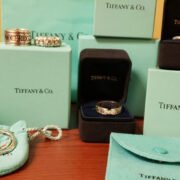If you think white diamonds are rare, wait until you hear about their fancy color relatives. Estimates suggest that colored diamonds may account for less than a percent of all mined diamonds worldwide. This rarity is what causes the world’s most vivid colored diamonds to sell for millions at auction!
A range of diamond colors, including blue and black options, are growing in popularity for engagement rings, pendant necklaces, and much more.
However, if you’re choosing colored diamonds for a meaningful piece of jewelry, their relative rarity may make it hard to know what to look for. What are black and blue diamonds, and what should you expect from them? How are they different from classic white diamonds?
Let’s take a look at everything you should know about these stunning gems.
Colored vs. White Diamonds
Before we jump more in-depth into blue and black diamonds, let’s talk about what sets colored diamonds apart from the clear, white diamonds we know and love.
Color in White Diamonds
It’s easy to get confused about the “color” component of a diamond. When we talk about the 4Cs of diamonds, color is one of the markers of a diamond’s quality.
Jewelers assess traditional white diamonds based on how pigmented they are. There are multiple factors that can cause extra pigmentation.
When certain elements are present during a diamond’s formation, these impurities can create a discolored look. Nitrogen is the most common culprit for impurities. Structural defects in the diamond’s crystal matrix can also cause discoloration.
Experts use the D-to-Z color-grading scale to measure these gems’ degree of colorlessness. Diamonds with a D grade are colorless, while diamonds with a Z grade have an obvious tint, often brown or yellow. Diamonds with less color are prized for their higher quality and are thus more expensive.
Color in Fancy Diamonds
There are certain types of diamonds in which we do want additional color. These diamonds are called “fancy diamonds” or “fancy color diamonds.”
Fancy diamonds come in a wide range of hues, including blue and black. These specimens are prized for their rarity and unusual color, making them very valuable.
These unique diamonds also use the D-to-Z color-grading scale, but the quality expectations are reversed. Diamonds with a Z grade have vivid coloration, making them more valuable, while diamonds with a D grade have muted colors, making them less so.
The other 4Cs, including cut, clarity, and carat weight, work in the same ways for most of the fancy diamonds as they do white diamonds, though black diamonds are the exception. A gem with a more precise cut and fewer imperfections, for example, will often be graded higher than one with poor proportions and dark inclusions.
The Basics of Blue Diamonds
Where nitrogen causes yellow or brown tints in white diamonds, blue diamonds have boron to thank for their unique shade. This element absorbs the red, yellow, and green hues of the color spectrum. The result is a beautiful blue color that can vary from gem to gem.
Blue diamonds are also graded by their purity. Pure blue diamonds have no hydrogen present, while impure diamonds may have trace amounts of hydrogen. This hydrogen may cause gray or violet tinges to form in the gem.
Like white diamonds, blue diamonds can give off a brilliant, fiery gleam when cut and set well. These popular diamonds are also among the rarest types of diamonds in the world. Only a handful of diamond mines have ever produced blue diamonds.
For this reason, some of the largest and most brilliant natural blue diamonds can sell for millions at auction, as we mentioned above. Lighter blue diamonds will have a lower price tag, often a few hundred dollars per carat. You can find these diamonds in a range of color intensities, from a grade of Faint Blue to Fancy Deep or Fancy Dark, the strongest blue diamond shades.
Synthetic blue diamonds, on the other hand, often have similar price tags to mined white diamonds. This makes them an ideal choice for anyone who loves the stunning hue but not the high expense.
The Basics of Black Diamonds
Natural black diamonds, also called Carbonados, may get their dark color from a variety of sources. Graphite, pyrite, and hematite are common mineral combinations that cause the distinctive black hue.
Unlike white and blue diamonds, black diamonds are not transparent, at least when they have large enough quantities of minerals inside of them. Their opaque surfaces don’t show the brilliant sparkle we often associate with diamonds. This is because the crystal structure and the minerals within the gem absorb much of the light.
As a result, it’s impossible to grade black diamonds on the usual clarity scale. Experts consider the heavy, opaque inclusions a feature of the gem, not a defect.
Black diamonds are often less expensive than other types of white or fancy color diamonds. This is due in part to the lower demand for these gems: though they’re quickly growing in popularity today for engagement rings and more, they were historically considered less desirable than other diamond types.
If you are considering a natural black diamond, keep in mind that these stones may be slightly more prone to breakage than their colorless counterparts, though it’s more common in larger stones than smaller ones. The microscopic fractures that make up the natural structure of these gems can also make them vulnerable to hard blows.
It’s also worth noting that many black diamonds are now lab-made. Specialists will sometimes enhance the color of a white diamond that already has heavy inclusions. High-pressure treatments and artificial irradiation can darken these lab-made stones, turning them black.
Find the Perfect Diamond Colors
Every diamond is unique, no matter the makeup. Whether you love the traditional look of a white diamond, the vivid hue of a blue stone, or the striking opacity of a black gem, it’s easy to find the perfect diamond colors to match.












